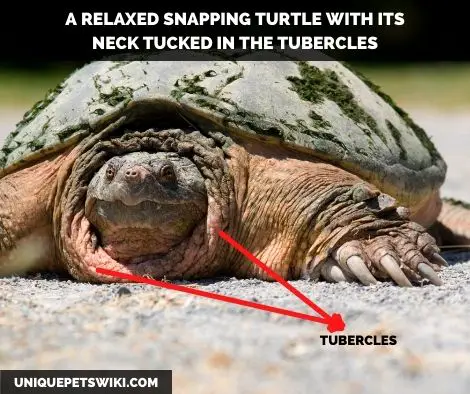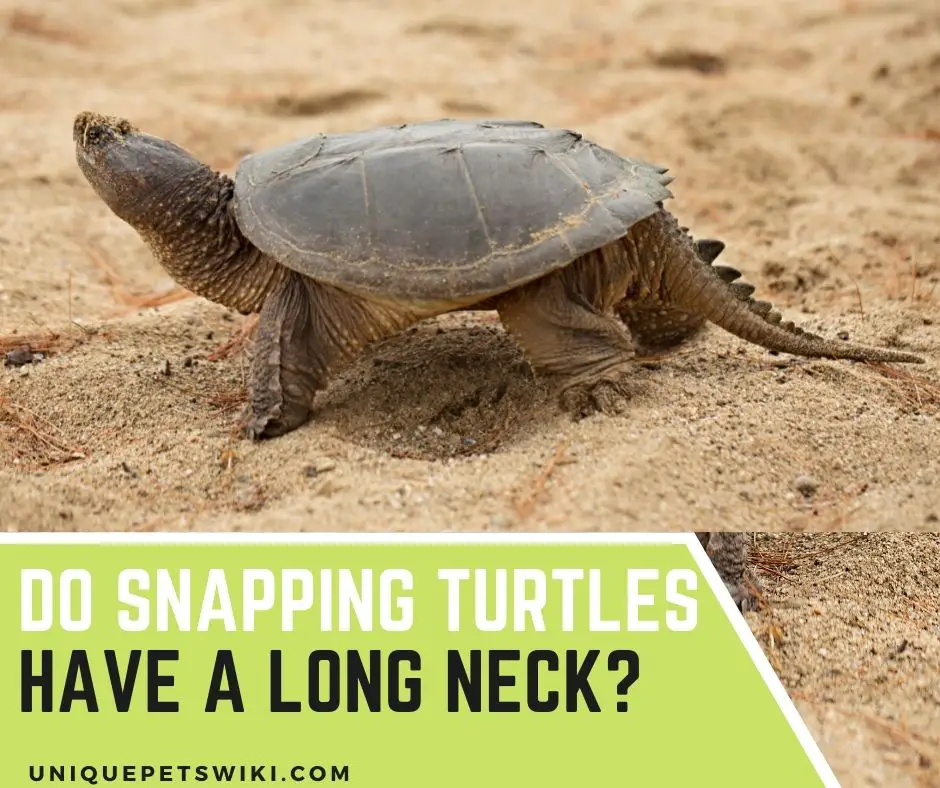Mike, one of my friends who is new to snapping turtles once asked “Sometimes, my snapping turtle stretches his neck very long, is he trying to bite me or what? Do Snapping Turtles Have A Long Neck? Does he want to feed more? Or is he just exploring the surroundings?”
Maybe you’re just like Mike wondering the same, snapping turtles long neck article has answers to all these questions.
Snapping Turtles have a history of being aggressive and biting off fingers that would make you worry about their neck. Since they don’t have doomed shells to protect them when faced with an attack, their long necks, sharp beaks, and powerful jaws become tools that they use to defend themselves.
Hence, as a keeper, understanding how long snapping turtles’ necks is and how they use it to defend themselves is very important so that you can minimize the risk of getting bitten by your pet.
Let’s get into the article in detail.
This article has been reviewed by Dr. Gospel. Read more about our knowledge control process here.
Contents
Do Snapping Turtles Have A Long Neck: What Does A Snapping Turtle’s Neck Look Like?
Long, flexible, rough, and with characteristic bumps called tubercles are just the words to describe the snapping turtle’s neck. When they are at rest, their necks are usually tucked in the tubercles, revealing only a small part of the head.

However, what you didn’t know is that their necks can stretch out to a distance as long as their shell, and most importantly, they can move in any direction.
Therefore, if you come across a snapping turtle with the neck tucked in, you would want to carry or move it with caution.
Why Does My Snapping Turtle Have A Very Long Neck?
The best answer to why snapping turtles have long necks is that they are naturally designed with long necks as a necessary feature for survival in the wild.
Although they have long necks, they don’t always stretch it out all the time. They only do this for some reason.
Wild snapping turtles will stretch out their necks when hunting, trying to defend themselves from predators or an attack, when feeding, and when just exploring their habitat.
On the contrary, the reasons for stretching out their necks in captivity will vary since the circumstances in captivity are different. Captive snapping turtles are not faced with predation attacks.
But since these animals can’t differentiate between a predator and someone who means well to them, they tend to act in defense by stretching out their necks to bite. This will mostly happen during the first few days that you just got the animal. However, as you keep feeding the animal, in the long run, he’ll associate you with food and may not scare you.
That notwithstanding, even when your snapper is familiar with you, if he feels unsafe when you approach the tank, he will stretch out his neck to bite.
One other reason your snapping turtle is stretching out his neck is because he’s hungry. This will happen if you haven’t fed him in a long while. In this case, his stretching means: “hey! Can you give me some food because I’m starving.”
Sometimes, one or two things can go wrong in your turtle’s habitat that causes him serious discomfort to want to escape. These can be poor water quality, higher temperature, or even stress.
Any of these faults in the habitat if it becomes unbearable can make your snapping turtle stretch out his neck in an attempt to escape.
Aside from burrowing, exploring its habitat is what snapping turtles are known for in the wild. Hence, if your snapper isn’t burrowing or resting and he feels bored, he’ll stretch out his neck to explore.

These are just a few reasons your pet snapping turtle would stretch his neck very long. This is just to say that, your snapper may have other reasons for stretching his neck and would want to communicate that to you. But if you don’t know his body language, it may be difficult to understand.
Therefore, the bottom line is, study your individual pet to understand his body language. If your pet is a female, it might even be that she wants to get out of the water to lay eggs.
Do All Snapping Turtles Have Long Necks?
Yes, all adult and hatchling snapping turtles, both male and female have long necks.

How Long Is A Snapping Turtle’s Neck?
The length of a snapping turtle’s neck is equivalent to the length of its shell. This is to say that snapping turtles have long necks that can measure up to 19 inches and can extend as long as its body.
On average, the snapping turtles’ necks measure about 8 – 14 inches. The older and bigger they get, the bigger and longer the neck. That said, the longest snapping turtle’s neck ever recorded measures 19 inches.
In addition, the striking distance over the shell is approximately one-half to two-thirds of the shell length (that is, the length to which snapping turtles can extend their necks to bite).
Although a full shell length is a safe distance to handle a snapping turtle, a threatened turtle will approach to bite you. And when it does, the bite is really painful.
The Benefit Of A Snapping Turtle’s Long Neck
Why snapping turtles have Long necks or the benefits of snapping turtles’ long necks isn’t far-fetched from their hunting habit and defense technique in the wild.
In the wild, snapping turtles hunt by lying in wait, wiggling the worm-like appendage in their mouths to lure prey. So, when the prey gets close enough to eat what looks like a worm they would stretch out their necks to snap at the prey.
Most importantly, the main reason snapping turtles have long necks is to defend themselves when attacked. They can use a long neck, sharp beaks, and powerful jaws to protect themselves.
Thus, when they’re faced with an attack they can use these things to fight back. The fact that their necks can move in any direction makes it possible for them to bite a predator from any direction.
Also, snapping turtles have their name from their habit of snapping at prey and predators. This means that even from a distance, they can stretch out their necks to snap or capture prey such as fish, frogs, and crayfish.
Wrapping Up
The snapping turtle’s neck is a part of their body you should know a lot about since they have a history of biting off one’s finger when held inappropriately. Snapping turtles not only have long necks that can extend as long as their body but are flexible and can move in any direction.
This means that, if you hold these animals from a region that their necks can extend to, they’ll bite you.
Ideally, if you have any reason to handle or move a snapping turtle from one spot to another, hold the animal by the back of its shell and gently move it. If the turtle is so big that you can’t lift it up by just holding the back of its shell, try placing one of your palms (hands) on its plastron (under its belly) towards the back to lift it up.
Do not hold a snapping turtle by its tail because it can bend its neck downward to bite you. Do not also place your hands near the front half by the sides of the turtle because its neck can extend to that extent.
Read our article here for more information about how to safely handle, hold and move a snapping turtle.
